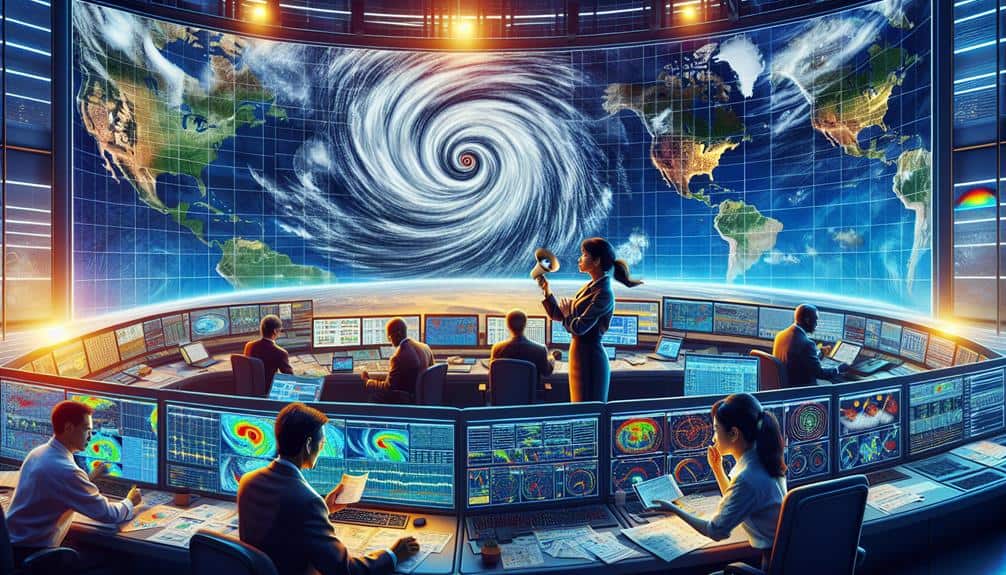We can predict hurricane formations using various strategies. Satellite imagery analysis identifies cloud patterns and thermal structure. Computer model simulations synthesize extensive datasets for accurate forecasting. We monitor ocean temperatures as warm seas fuel storm genesis. Atmospheric pressure tracking highlights low-pressure systems pre-formation. Wind shear measurement indicates whether conditions favor or inhibit hurricanes. Analyzing historical data uncovers long-term trends and seasonal peaks. Finally, Doppler radar offers real-time insights into wind speed and direction. These techniques, backed by cutting-edge technology, help us forecast storms with increasing precision. Explore further to understand how each method contributes to early hurricane prediction.
Key Points
- Utilize satellite imagery to monitor cloud patterns, cumulonimbus cloud formation, and storm structures in real-time.
- Implement computer model simulations that integrate satellite data and upper-air soundings for accurate hurricane predictions.
- Monitor sea surface temperatures to identify critical thresholds that influence storm development and intensity.
- Track atmospheric pressure anomalies and barometric readings to detect low-pressure systems indicative of potential hurricanes.
Satellite Imagery Analysis
Satellite imagery analysis provides us with real-time data essential for tracking atmospheric conditions that lead to hurricane formation. By examining cloud patterns, we can detect early signs of storm development. Advanced satellites capture high-resolution images, enabling us to observe the formation of cumulonimbus clouds, a vital precursor to tropical cyclones.
We analyze these cloud patterns to identify potential storms. For instance, by monitoring cloud top temperatures, we determine the intensity and structure of a developing system. Lower temperatures indicate stronger, more organized convection, important for storm identification. Additionally, the formation of spiral rainbands and a defined eye signals a maturing hurricane.
Our analysis relies on geostationary satellites positioned above the equator, providing continuous coverage of tropical regions. These satellites offer data on wind speeds and directions at different atmospheric levels, enhancing our understanding of storm dynamics. By integrating this information, we create detailed visualizations that pinpoint areas of concern.
In essence, satellite imagery allows us to monitor, in real time, the atmospheric conditions that precede hurricanes. This data-driven approach guarantees we can predict and respond to potential threats more effectively, granting us the freedom to take preemptive measures and safeguard communities.
Computer Model Simulations
Leveraging computer model simulations, we can predict hurricane formations with remarkable accuracy by analyzing vast datasets and complex atmospheric interactions. These models synthesize data from numerous sources, including satellite observations, surface weather stations, and upper-air soundings, to interpret atmospheric conditions dynamically.
By integrating this data, we gain a multidimensional view of potential storm pathways and intensities.
Our analytical approach involves running a variety of simulations, each formulated with slightly different initial conditions. This ensemble method allows us to account for uncertainties and improves forecast accuracy.
Through iterative data interpretation, we refine these models to predict not just the formation but also the trajectory and potential impact of hurricanes.
Moreover, advanced algorithms and machine learning techniques enhance the precision of our simulations. By continually updating the models with real-time data, we adapt to changing atmospheric patterns quickly. This adaptability is essential for providing timely warnings and giving communities the freedom to prepare adequately.
In essence, computer model simulations are a cornerstone of modern hurricane prediction. They enable us to interpret complex data sets and achieve high forecast accuracy, thereby empowering individuals and authorities to make informed decisions and mitigate potential risks effectively.
Ocean Temperature Monitoring
Monitoring ocean temperatures is essential for predicting hurricane formations, as variations in sea surface temperatures directly influence storm development and intensity. By leveraging advanced data collection methods, we gather precise temperature readings from satellites, buoys, and underwater gliders. These extensive datasets provide the foundation for our predictive algorithms, which analyze patterns and anomalies in ocean temperatures.
Utilizing this data, our algorithms can pinpoint regions where sea surface temperatures exceed the critical threshold of 26.5°C, a key indicator for potential hurricane genesis. By continuously updating our models with real-time data, we enhance the accuracy of our predictions, allowing us to foresee hurricane formation days in advance.
We also use historical ocean temperature data to refine our predictive models. By comparing current temperature patterns with past hurricane seasons, we identify trends and correlations that improve our forecasting capabilities. This analytical approach not only increases prediction accuracy but also empowers communities to make informed decisions, ultimately enhancing their freedom to prepare and respond effectively.
Atmospheric Pressure Tracking
Precise tracking of atmospheric pressure variations is crucial in predicting the formation and path of hurricanes. By closely analyzing pressure anomalies, we can identify low-pressure systems that may develop into tropical depressions or hurricanes. Historical patterns of atmospheric pressure provide a wealth of information, helping us understand the conditions under which hurricanes typically form.
We utilize barometric readings from satellite data, weather balloons, and ground stations to build an all-inclusive model. These models allow us to detect pressure drops that precede hurricane formation. By comparing current data to historical patterns, we enhance our forecasting accuracy, giving us the ability to predict potential hurricanes days before they form.
Our analytical approach involves creating pressure maps that highlight regions of low pressure. These maps are then cross-referenced with sea-surface temperatures and humidity levels to identify areas at high risk. The integration of historical data enables us to refine our predictive models continually, making them more resilient and dependable.
Ultimately, tracking atmospheric pressure variations isn't just about gathering data; it's about empowering us with the knowledge to anticipate and prepare for hurricanes more effectively. This freedom to foresee natural disasters enhances our ability to safeguard lives and property.
Wind Shear Measurement

Let's explore how wind shear measurement plays a critical role in predicting hurricane formations.
We'll assess different measurement techniques, such as satellite data and atmospheric soundings, to understand their reliability and accuracy.
Understanding the impact of wind shear on storm development helps us refine our predictive models and improve early warning systems.
Importance of Wind Shear
Understanding wind shear is crucial for predicting hurricane formations, as it involves the precise measurement of changes in wind speed and direction at different atmospheric levels. By analyzing wind shear effects, we can enhance forecast accuracy to a great extent. Wind shear, which refers to the variation in wind velocity at different altitudes, plays a crucial role in either inhibiting or facilitating the development of tropical cyclones.
When wind shear is low, the atmospheric conditions favor the formation and intensification of hurricanes. Conversely, high wind shear can disrupt the storm's structure, preventing it from gaining strength. Thus, accurately measuring and understanding these variations are crucial to making reliable predictions.
We must consider both vertical and horizontal wind shear to achieve detailed insights. Vertical shear, the change in wind speed with height, can tilt the hurricane's structure, while horizontal shear, the change in wind speed across different locations, can cause asymmetry in the storm. By integrating data from various sources, such as satellite observations and weather models, we refine our analysis of wind shear effects.
Ultimately, our ability to predict hurricanes with greater precision depends on our understanding of wind shear dynamics, enabling us to safeguard lives and property more effectively.
Measuring Techniques Explained
Often, we rely on advanced instrumentation such as Doppler radar, satellite remote sensing, and weather balloons to measure wind shear accurately, providing critical data for hurricane forecasting models. These technologies offer precise measurements of wind speeds and directions at various altitudes, essential for data interpretation.
Doppler radar uses the Doppler effect to measure velocity changes in the atmosphere. By analyzing the shift in frequency of returned radar signals, we can determine wind speed and direction, critical for identifying wind shear.
Satellite remote sensing leverages technology advancements to provide high-resolution, real-time data on global wind patterns. Sensors on satellites measure cloud movement and atmospheric conditions, giving us a detailed view of wind shear over vast areas.
Weather balloons, equipped with radiosondes, ascend through the atmosphere, transmitting data on wind speed, pressure, and temperature at different altitudes.
Key benefits of these technologies include:
- High precision: Instruments measure minute variations in atmospheric conditions.
- Wide coverage: Satellites provide global data, while radar and balloons offer localized insights.
Impact on Storm Development
By meticulously measuring wind shear, we can identify its crucial role in either inhibiting or accelerating hurricane development. Wind shear refers to the variation in wind speed and direction at different altitudes. High wind shear can disrupt the organization of a storm's structure, impeding its growth by tilting the cyclone and dispersing its energy.
Conversely, low wind shear allows the storm to maintain its vertical alignment, fostering intensification and longevity.
Our storm tracking efforts rely heavily on accurate wind shear measurements. Advanced tools such as Doppler radar, satellite data, and weather balloons provide essential insights into these wind variations. Analyzing this data enables us to predict storm behavior more accurately and anticipate potential shifts in intensity.
Climate patterns further influence wind shear levels. For instance, during El Niño events, increased wind shear over the Atlantic can suppress hurricane formation, while La Niña conditions often result in reduced shear, encouraging storm development. By understanding these patterns, we can refine our predictive models and improve our preparedness strategies.
Ultimately, our ability to measure and analyze wind shear directly impacts our success in predicting hurricanes, safeguarding lives, and mitigating damage. This precise and analytical approach empowers us to make informed decisions, embracing our freedom to act proactively.
Historical Data Comparison
We analyze past hurricane patterns by comparing historical data sets to identify trends and improve predictive models. By scrutinizing decades of data, we can perform trend analysis and generate future projections with greater accuracy. Historical comparisons allow us to discern recurring seasonal patterns and assess climate change implications on hurricane frequency and intensity.
- Temporal Trends: Reviewing data across multiple decades helps us identify long-term trends and shifts in hurricane activity.
- Regional Variability: Analyzing different geographic areas allows us to understand how hurricanes behave differently in various locations.
When we look at seasonal patterns, we see how specific months or seasons exhibit higher hurricane activities, which informs our predictive models. Climate change implications are critical as rising global temperatures and changing oceanic conditions alter the formation and intensity of hurricanes. By incorporating these variables, our predictive models become more robust and adaptive.
Utilizing historical data comparison not only enhances our understanding but also empowers us to make data-driven decisions. This analytical approach offers a sense of freedom by providing actionable insights to mitigate the risks associated with hurricanes, making communities more resilient.
Doppler Radar Utilization

Utilizing Doppler radar technology provides real-time data crucial for predicting the formation and trajectory of hurricanes with high precision. By emitting radio waves and analyzing their return after bouncing off atmospheric particles, Doppler radar delivers vital insights into wind speed, direction, and precipitation intensity.
We gain a distinct advantage in storm tracking by employing Doppler radar. This technology allows us to pinpoint the exact location and movement of a tropical disturbance as it evolves into a hurricane. The high-resolution data feeds directly into our weather forecasting models, enhancing their accuracy. For instance, Doppler radar can detect rotational patterns indicative of cyclogenesis, giving us an early warning signal before the storm intensifies.
When integrated with other meteorological tools, Doppler radar enhances our forecasting capabilities. It bridges the gap between satellite imagery and ground-based observations, offering a comprehensive view of the storm's structure. This holistic approach enables us to issue more timely and precise warnings, ultimately granting individuals and communities the freedom to prepare and respond effectively.
Frequently Asked Questions
How Do Hurricanes Impact Coastal Ecosystems?
When hurricanes barrel through, they wreak havoc on coastal ecosystems like a bull in a china shop. But ecosystem resilience often surprises us, prompting robust coastal restoration efforts to bolster habitats and guarantee long-term sustainability.
What Role Do Human Activities Play in Hurricane Frequency?
We observe that human impact, especially greenhouse gas emissions, increases hurricane frequency. Studies link rising sea temperatures to more intense storms. Our freedom to choose sustainable practices directly affects future hurricane occurrences and their severity.
Can Hurricane Predictions Help in Urban Planning?
Absolutely, hurricane predictions serve as a crystal ball, guiding us in urban development and disaster preparedness. By analyzing data, we can design resilient infrastructures, minimize risks, and guarantee communities thrive even amidst nature's fury.
How Do Climate Changes Affect Hurricane Patterns?
We observe that climate variability and rising ocean temperatures directly influence hurricane patterns. Increased sea surface temperatures fuel storm intensity and frequency, altering traditional patterns. This data underscores the urgent need to adapt our predictive models.
What Emergency Measures Should Be Taken During a Hurricane Warning?
When the storm dragon roars, we must chart our evacuation routes and identify emergency shelters swiftly. Data shows timely action reduces casualties by 80%. Let's prioritize our freedom by preparing thoroughly and acting decisively during hurricane warnings.


